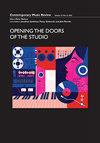塞尔维亚音乐身份:介绍
IF 0.1
2区 艺术学
0 MUSIC
引用次数: 0
摘要
我们决定将这期《当代音乐评论》的双月刊献给塞尔维亚音乐身份的主题,有几个原因。身份的概念意味着某些个人或集体特征的存在,或一个特征,通过它,某个人或社会群体是可识别的。“音乐认同”和“民族认同”都是难以捉摸的、灵活的、多变的、依赖于语境的概念。本期发表的文章帮助我们思考这两种类型的身份是否、何时以及在什么条件下交叉,以及从这种重叠中产生什么样的音乐作品。塞尔维亚的例子很能说明问题,因为这个嵌套在欧洲东南部地区的国家,自20世纪初以来多次改变其边界、名称和政治制度,加入了更大的联邦(君主制或共和国),只是后来又独立了。这些动态且仍在进行的变化,是塞尔维亚这个持续不稳定地区的民族认同(多元)问题相当复杂的主要原因。这种动荡不可避免地影响到塞尔维亚生活的各个方面,包括其文化生产。对于艺术音乐的作曲家来说,这些不断的变化在寻求定义、定位和识别自己的音乐方面提出了挑战。这两期的文章集中在塞尔维亚音乐身份的复杂问题上,通过研究作曲家在他们的作品中融入传统和民间动机、叙事和神话的方式,以及民间和“艺术”音乐习语的合成如何在国家本身和更广泛的后南斯拉夫/西巴尔干地区境内外塑造作曲家的文化身份。因此,这些研究提供了一个历史,政治和社会文化当代音乐评论,2022卷41,5-6号,459-466,https://doi.org/10.1080/07494467.2022.2198830本文章由计算机程序翻译,如有差异,请以英文原文为准。
Serbian Musical Identity: An Introduction
There are several reasons why we decided to dedicate this double issue of Contemporary Music Review to the topic of Serbian musical identity. The concept of identity implies the existence of some individual or collective characteristic, or a feature, by which a certain person or social group is recognisable. Both ‘musical identity’ and ‘national identity’ are elusive, flexible, changeable, and context-dependent notions. The articles published in this issue help us consider whether, when, and under what conditions these two types of identities intersect and what type of musical works emerge from such overlaps. The example of Serbia is illustrative because this country, nested in the southeastern region of Europe, has changed its borders, names, and political systems several times since the beginning of the twentieth century, joining larger federations (monarchies or republics), only to later become independent again. These dynamic and still ongoing changes are the principal reason why the issue of national identities (in the plural) in Serbia, a continuously unstable region, is quite complex. Such volatility has inevitably affected all aspects of life in Serbia, including its cultural production. For composers of art music, these incessant changes have posed challenges in seeking to define, position, and identify themselves musically. The collection of articles in this double issue focuses on the complicated question of Serbian musical identity by examining the ways composers incorporate traditional and folk motives, narratives, and myths in their compositions, and how the syntheses of folk and ‘art’music idioms shape the composers’ cultural identity both within and beyond the borders of the country itself and the wider post-Yugoslav / Western Balkan region. Thus, the studies offer a historical, political, and socio-cultural Contemporary Music Review, 2022 Vol. 41, Nos. 5–6, 459–466, https://doi.org/10.1080/07494467.2022.2198830
求助全文
通过发布文献求助,成功后即可免费获取论文全文。
去求助
来源期刊

Contemporary Music Review
MUSIC-
CiteScore
1.00
自引率
25.00%
发文量
48
期刊介绍:
Contemporary Music Review provides a forum for musicians and musicologists to discuss recent musical currents in both breadth and depth. The main concern of the journal is the critical study of music today in all its aspects—its techniques of performance and composition, texts and contexts, aesthetics, technologies, and relationships with other disciplines and currents of thought. The journal may also serve as a vehicle to communicate documentary materials, interviews, and other items of interest to contemporary music scholars. All articles are subjected to rigorous peer review before publication. Proposals for themed issues are welcomed.
 求助内容:
求助内容: 应助结果提醒方式:
应助结果提醒方式:


